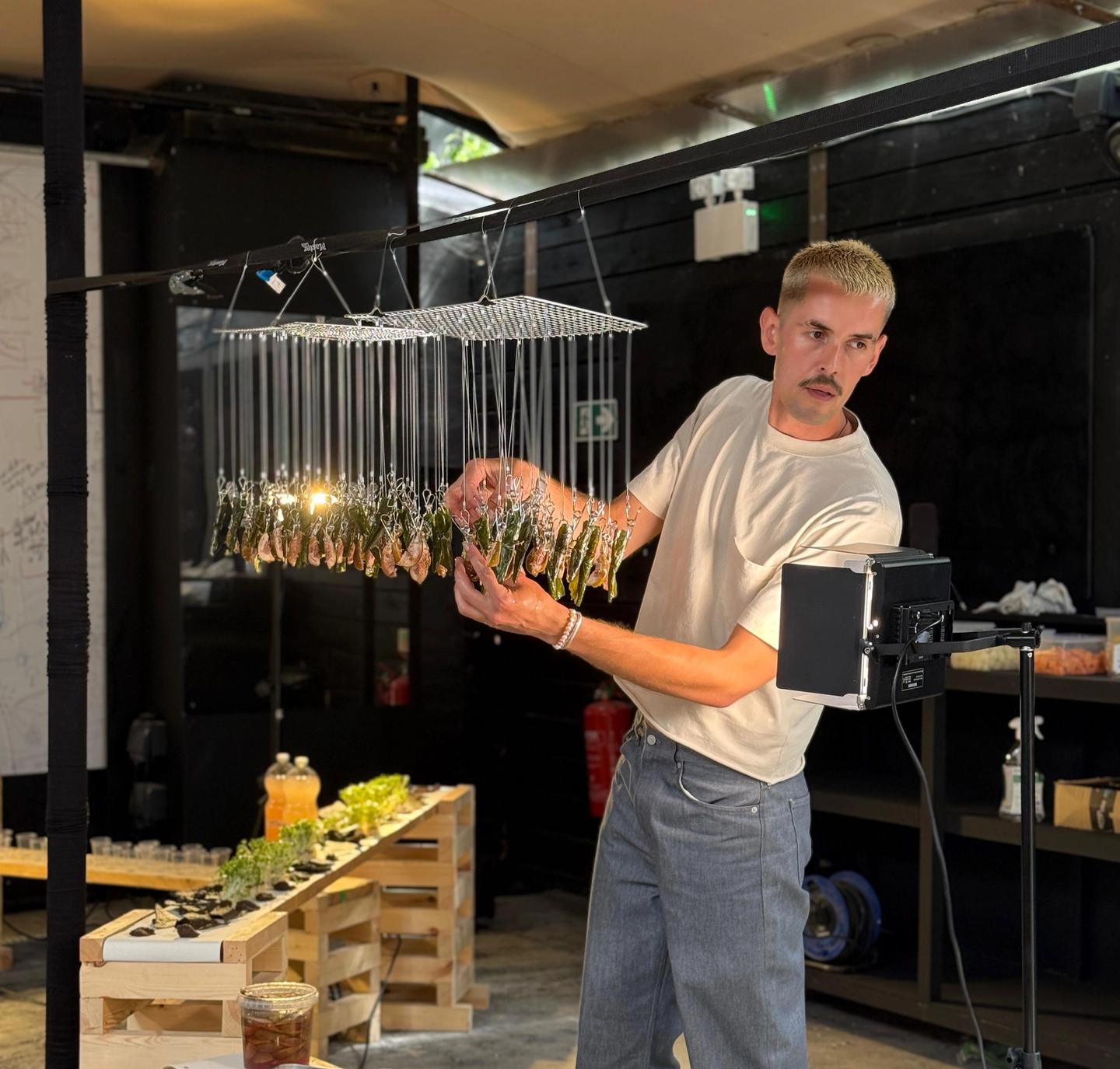

The term ‘mould’—or ‘mold’ in American English—is polysemic; it has multiple meanings. Not only is it the fungus that grows from decaying food; it is also something which forms, or gives shape. These meanings do not share etymological roots, but they are nonetheless remarkably related, for both can be construed to be inherently formative in their meaning.
Apt, then, that a publication dedicated to exploring the future of food should also share this name. When I speak to MOLD’s founder LinYee Yuan, she tells me the name came from the magazine’s anti-food-media focus. In the context of food, mould is, in her words, highly undesirable, grotesque, and wretched; yet it is also something that gives form. These formative attributes present themselves as ideal generative concepts, for which the magazine is eponymously titled MOLD.
Just like its polysemic namesake, MOLD is multifaceted, examining food futures from a range of perspectives, such as social and environmental justice, to how design can innovate food systems. As such, LinYee doesn’t consider MOLD a food publication; it is, in fact, the antithesis. When it was founded in 2013, it was an industry first in its focus on food futures, and has since then led through innovation.
By contrast, in mainstream food media the nexus of food and publishing predominantly focuses on deliciousness—what LinYee calls food pornography; presenting a vicarious experience which tastefully intertwines text and image, endeavouring to maximally engage our senses. This isolated focus on food as a finished product negates the impacts involved in its processes of elaboration, absolving consumers of any consciousness surrounding it.
By contrast MOLD, like mould, builds by deconstructing; looking not only at food, but everything it impacts, and is impacted by. This macro outlook continues to define MOLD’s unique perspective; one to which mainstream food media is now catching up. In the past decade, LinYee has seen widespread editorial shifts towards a more conscious outlook, which is, in large part, thanks to MOLD’s pioneering publishing.
Today, publishing on food solely for its taste has become a somewhat stale perspective. Instead, mainstream outlets are responding to the growing social awareness around the impacts of our food systems. This is evidenced by food writer Alesha Kennedy’s MOLD article (https:// https://thisismold.com/ipcc/ipcc-lifestyle-analysis) being published in Mark Bittman’s Best American Food Writing 2023; as LinYee puts it, “an honour I didn’t know that I wanted.”
Yet, despite this shift, LinYee believes there’s still a long way to go. Most outlets enter the conversation around the future of food from an environmental perspective, only focusing on climate change without considering climate justice. Climate change tends to affect people of the global majority, who often had the least to with causing it. Climate justice seeks to equitably redistribute the burdens climate change causes, equitably redistribute these burdens, and LinYee believes the future of food is key to this.
It is easy enough to identify an issue, but less so to address it. In her 10 years at the head of MOLD, LinYee has learned that the crises the magazine writes about are best addressed through small, local initiatives, where power is decentralised and communities are given autonomy over their food. There is no panacea for what we face, rather there are myriad ways they can be approached, which can collectively affect widespread change. She believes publications such as Condé Nast’s Bon Appétit—a “juggernaut” of mainstream food media—are thus limited by the size of their readership, as their ‘one size fits all’ approach prevents them from engaging with smaller, topical issues.
To contextualise this, she cites the diets of her Chinese-American/Portuguese children being raised in the mixed Trinidadian and Orthodox Jewish diaspora of her local New York neighbourhood. To begin to approach how one might address issues of climate crises with any agent in this hyper-localised food ecology requires an intimate knowledge of its’ network, something which a global approach will be largely ineffective at affecting.
In this, the intimacy of eating* comes to the fore. Much of what we eat comes at the cost of those who produce it, largely due to the economies of scale at which it is produced. This is not a palatable salespoint, so the processes behind our foods are often hidden to assuage our guilt. By reducing the degrees of separation between ourselves and our food, we can begin to see how food impacts climate justice, and bring humanity back into what has become a largely inhuman concept: the origins of our food.
Cue MOLD’s latest venture. In 2021, the magazine put their words into practice and founded the innovative Brooklyn-based non-profit arts organisation Field Meridians. Through this offshoot, the local community was asked what the future of their food might look like, with the intent of actioning real, localised outcomes. Initiatives were then put in place, and local residents were engaged in what has now become a pioneering project.
The organisation aims to bring food sovereignty to Brooklyn by focusing on what a place-based food future might look like. Field Meridians continues to grow, and this year they’ll open a nature centre to engage the community in locating nature in their city. LinYee Believes that in better knowing our landscapes we can create a more profound connection with it, and learn the unique nuances of our local food ecologies. Field Meridians is a leading example of how local, place-based initiatives can reconnect people with place. Through its success, LinYee hopes it will provide inspiration for how others might begin their own, hyper-localised organisations to reconnect communities to their landscapes, and build towards a more secure, decentralised food future.
LinYee calls MOLD a project; suggesting it to be a work-in-progress rather than a finished product. I see this perspective as key in MOLD’s innovation, for it enables it to shift and change, take new form and develop as is needed. Both mould, the fungi, and mould, the form, mean different things; come from different roots; and essentially oppose one another—the former breaking down; the latter give form. Yet, despite their differences, they share in the term ‘mould’ the concept of formation; of creating something from something else. This is, in essence, MOLD: an idea that, through the lens of food, takes our crises, deconstructs them, and reforms how they might be. Just like mould, and mould, MOLD construes anew, offering us insights into food futures we otherwise might not have seen.
—
*The subject originally comes into the conversation when I quote LinYee’s 2021 It’s Nice That article, that "Besides sex, eating is the only thing we do that engages all of our senses.” In 2013 when she founded MOLD, there was a very present narrative around convenience culture in both sex and food. At the time, Soylent Green was stifling what food culture Silicone Valley had with its nutritional singularity; itself part of a larger trend in reducing the time spent on non-labour-orientated pursuits such as cooking so that we might work more. Though this trend has largely passed, it continues to influence how many view food, making the intimacy of eating all the more important.
(https://dahlia-blue-ntw3.squarespace.com/journal?author=63c129098c4bc3088aeafe64)

Barney is a London-based culinary creative working at the confluence of food, art, and writing, whose practice focuses on food futures, queering consumption, and foraging and fermenting as social resistance. He believes food, in its ubiquity, transcends language as a mode of communication, and by applying it as an artistic medium it can be used to impart new thinking. In his practice, he uses food both to communicate his thinking and as a point of departure for research.
In 2021 he founded Finger Food Magazine : a contributor-based space for stories, artwork, and essays, in any and all mediums, exploring cooking, craft, and creation. When he’s not jamming ferments into jars, peering at plants on the pavement, or writing ramblings for my Substack , you can usually find him foraging for his food or reading books on baking.
